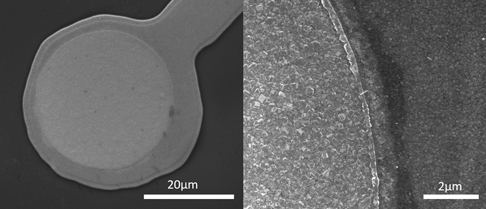Crossref Citations
This article has been cited by the following publications. This list is generated based on data provided by
Crossref.
Meijs, Suzan
McDonald, Matthew
Sørensen, Søren
Rechendorff, Kristian
Fekete, Ladislav
Klimša, Ladislav
Petrák, Václav
Rijkhoff, Nico
Taylor, Andrew
Nesládek, Miloš
and
Pennisi, Cristian P.
2018.
Diamond/Porous Titanium Nitride Electrodes With Superior Electrochemical Performance for Neural Interfacing.
Frontiers in Bioengineering and Biotechnology,
Vol. 6,
Issue. ,
Jakubcová, Barbora
Turňová, Jana
Řehounek, Ondřej
Polák, Jiří
Mineva, Andrea
Taylor, Andrew
Hubík, Pavel
Petrák, Václav
and
Petráková, Vladimíra
2018.
Neuron Adhesion on Diamond: Competition between Polymer Treatment and Surface Morphology.
Advanced Engineering Materials,
Vol. 20,
Issue. 9,
Kshirsagar, Pranoti
Dickreuter, Simon
Mierzejewski, Michael
Burkhardt, Claus J.
Chassé, Thomas
Fleischer, Monika
and
Jones, Peter D.
2019.
Transparent Graphene/PEDOT:PSS Microelectrodes for Electro‐ and Optophysiology.
Advanced Materials Technologies,
Vol. 4,
Issue. 1,
Yang, Nianjun
Yu, Siyu
Macpherson, Julie V.
Einaga, Yasuaki
Zhao, Hongying
Zhao, Guohua
Swain, Greg M.
and
Jiang, Xin
2019.
Conductive diamond: synthesis, properties, and electrochemical applications.
Chemical Society Reviews,
Vol. 48,
Issue. 1,
p.
157.
Krůšek, Jan
Dittert, Ivan
Smejkalová, Tereza
Kořínek, Miloslav
Gottfriedová, Kristýna
Freislebenová, Hana
Neuhöferová, Eva
Klimša, Ladislav
Sedláková, Silvia
Taylor, Andrew
Mortet, Vincent
Petrák, Václav
Benson, Veronika
and
Petráková, Vladimíra
2019.
Molecular Functionalization of Planar Nanocrystalline and Porous Nanostructured Diamond to Form an Interface with Newborn and Adult Neurons.
physica status solidi (b),
Vol. 256,
Issue. 3,
Lounasvuori, Mailis M.
Nelson, Geoffrey W.
and
Foord, John S.
2019.
Novel Aspects of Diamond.
Vol. 121,
Issue. ,
p.
257.
Tomagra, Giulia
Aprà, Pietro
Battiato, Alfio
Collà Ruvolo, Cecilia
Pasquarelli, Alberto
Marcantoni, Andrea
Carbone, Emilio
Carabelli, Valentina
Olivero, Paolo
and
Picollo, Federico
2019.
Micro graphite-patterned diamond sensors: Towards the simultaneous in vitro detection of molecular release and action potentials generation from excitable cells.
Carbon,
Vol. 152,
Issue. ,
p.
424.
Jones, Peter D.
Moskalyuk, Anastasiya
Barthold, Clemens
Gutöhrlein, Katja
Heusel, Gerhard
Schröppel, Birgit
Samba, Ramona
and
Giugliano, Michele
2020.
Low-Impedance 3D PEDOT:PSS Ultramicroelectrodes.
Frontiers in Neuroscience,
Vol. 14,
Issue. ,
Białobrzeska, Wioleta
Głowacki, Maciej J.
Janik, Monika
Ficek, Mateusz
Pyrchla, Krzysztof
Sawczak, Mirosław
Bogdanowicz, Robert
Malinowska, Natalia
Żołędowska, Sabina
and
Nidzworski, Dawid
2021.
Quantitative fluorescent determination of DNA – Ochratoxin a interactions supported by nitrogen-vacancy rich nanodiamonds.
Journal of Molecular Liquids,
Vol. 342,
Issue. ,
p.
117338.
Yang, Weiyang
Gong, Yan
and
Li, Wen
2021.
A Review: Electrode and Packaging Materials for Neurophysiology Recording Implants.
Frontiers in Bioengineering and Biotechnology,
Vol. 8,
Issue. ,
Kuhn, Bernd
Picollo, Federico
Carabelli, Valentina
and
Rispoli, Giorgio
2021.
Advanced real-time recordings of neuronal activity with tailored patch pipettes, diamond multi-electrode arrays and electrochromic voltage-sensitive dyes.
Pflügers Archiv - European Journal of Physiology,
Vol. 473,
Issue. 1,
p.
15.
Krečmarová, Marie
Gulka, Michal
Vandenryt, Thijs
Hrubý, Jaroslav
Fekete, Ladislav
Hubík, Pavel
Taylor, Andrew
Mortet, Vincent
Thoelen, Ronald
Bourgeois, Emilie
and
Nesládek, Miloš
2021.
A Label-Free Diamond Microfluidic DNA Sensor Based on Active Nitrogen-Vacancy Center Charge State Control.
ACS Applied Materials & Interfaces,
Vol. 13,
Issue. 16,
p.
18500.
Baluchová, Simona
Brycht, Mariola
Taylor, Andrew
Mortet, Vincent
Krůšek, Jan
Dittert, Ivan
Sedláková, Silvia
Klimša, Ladislav
Kopeček, Jaromír
and
Schwarzová-Pecková, Karolina
2021.
Enhancing electroanalytical performance of porous boron-doped diamond electrodes by increasing thickness for dopamine detection.
Analytica Chimica Acta,
Vol. 1182,
Issue. ,
p.
338949.
Zhang, Hongyong
Rong, Guoguang
Bian, Sumin
and
Sawan, Mohamad
2022.
Lab-on-Chip Microsystems for Ex Vivo Network of Neurons Studies: A Review.
Frontiers in Bioengineering and Biotechnology,
Vol. 10,
Issue. ,
Santos, Nádia E.
Mendes, Joana C.
and
Braga, Susana Santos
2023.
The Gemstone Cyborg: How Diamond Films Are Creating New Platforms for Cell Regeneration and Biointerfacing.
Molecules,
Vol. 28,
Issue. 4,
p.
1626.
Tomagra, Giulia
Peroni, Giulia
Aprà, Pietro
Bonino, Valentina
Campostrini, Matteo
Carabelli, Valentina
Collà Ruvolo, Cecilia
Lo Giudice, Alessandro
Guidorzi, Laura
Mino, Lorenzo
Olivero, Paolo
Pacher, Luca
Picariello, Fabio
Re, Alessandro
Rigato, Valentino
Truccato, Marco
Varzi, Veronica
Vittone, Ettore
and
Picollo, Federico
2023.
Diamond-based sensors for in vitro cellular radiobiology: Simultaneous detection of cell exocytic activity and ionizing radiation.
Biosensors and Bioelectronics,
Vol. 220,
Issue. ,
p.
114876.
Dettlaff, Anna
Rycewicz, Michał
Macewicz, Łukasz
Rutecki, Paweł
Sawczak, Mirosław
Wittendorp, Paul
Jain, Shruti
Vereshchagina, Elizaveta
and
Bogdanowicz, Robert
2024.
Optimizing Ni–Cr patterned boron-doped diamond band electrodes: Doping effects on electrochemical efficiency and posaconazole sensing performance.
Talanta,
Vol. 278,
Issue. ,
p.
126519.



